| Listing 1 - 10 of 12 | << page >> |
Sort by
|
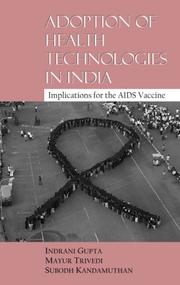
ISBN: 128201773X 9786612017735 8132101367 9788132101369 9780761935902 0761935908 9788178297392 8178297396 Year: 2007 Publisher: Los Angeles, Calif. SAGE Publications
Abstract | Keywords | Export | Availability | Bookmark
 Loading...
Loading...Choose an application
- Reference Manager
- EndNote
- RefWorks (Direct export to RefWorks)
The effectiveness of a new health technology is judged by both its accessibility. and also the extent to which it has been adopted in a particular country. With. the possibility of an AIDS vaccine in the near future, the International AIDS. Vaccine Initiative (IAVI) has emphasised the need for countries to prepare well. in advance for its smooth access and adoption. Reiterating IAVI`s appeal, this. book ably captures the course India needs to take for the successful adoption. and implementation of the AIDS vaccine in India. The first of its kind, this book examines the adoption of four health
AIDS vaccines --- HIV infections --- HIV disease vaccines --- Viral vaccines --- HIV (Viruses) infections --- HTLV-III infections --- HTLV-III-LAV infections --- Human T-lymphotropic virus III infections --- Lentivirus infections --- Sexually transmitted diseases --- Therapeutic use
Book
ISBN: 1283005204 9786613005205 9988647115 9988647808 9988647689 9789988647117 9789988647575 9988647573 9988647131 9789988647131 Year: 2007 Publisher: Accra, Ghana : Sub-Saharan Publishers,
Abstract | Keywords | Export | Availability | Bookmark
 Loading...
Loading...Choose an application
- Reference Manager
- EndNote
- RefWorks (Direct export to RefWorks)
A new novel from a scion of the new generation of writers in Africa. She tells the story of women in Africa: here it is misery, pain, agony , dilemmas, frustrations. She floats the reader on a world of inverted reality, which yet becomes the norm. With creative imagination, confronting the social realities, she seeks out the world of peace and tranquillity. But not without verisimilitude. The extremes of moral turpitude beget horrid outcomes, leaving suspense rather than resolution. Amma Darko is one of the most significant contemporary Ghanaian literary writers. She is the author of three pre
Mentally ill older people --- Mentally ill women --- Mothers --- HIV infections --- AIDS (Disease) --- Mentally ill aged --- Older mental patients --- Older mentally ill --- Older psychiatric patients --- Older people --- Women --- HIV (Viruses) infections --- HTLV-III infections --- HTLV-III-LAV infections --- Human T-lymphotropic virus III infections --- Lentivirus infections --- Sexually transmitted diseases --- Abuse of --- Ghana

ISBN: 9780334040026 0334040027 Year: 2007 Publisher: London SCM
Abstract | Keywords | Export | Availability | Bookmark
 Loading...
Loading...Choose an application
- Reference Manager
- EndNote
- RefWorks (Direct export to RefWorks)
AIDS (Disease) --- -HIV infections --- -241.63*8 --- 241.63*8 Theologische ethiek: ziekte en dood --- Theologische ethiek: ziekte en dood --- HIV (Viruses) infections --- HTLV-III infections --- HTLV-III-LAV infections --- Human T-lymphotropic virus III infections --- Lentivirus infections --- Sexually transmitted diseases --- Acquired immune deficiency syndrome --- Acquired immunodeficiency syndrome --- Acquired immunological deficiency syndrome --- HIV infections --- Immunological deficiency syndromes --- Virus-induced immunosuppression --- Religious aspects --- -Christianity --- Christian moral theology --- -Religious aspects

ISBN: 1280804998 9786610804993 0387337857 0387337849 1489998292 Year: 2007 Publisher: New York : Springer,
Abstract | Keywords | Export | Availability | Bookmark
 Loading...
Loading...Choose an application
- Reference Manager
- EndNote
- RefWorks (Direct export to RefWorks)
This comprehensive volume, written by experts in the field, is the first to address the biology of dendritic cells (DCs) in an integrated fashion, in the context of HIV infection and immunity. The book brings together the most recent information related to the biology of DCs and their role in the pathogenesis and immunity of HIV-1 infection. Recent research in immunology has revealed the key importance of DCs in the regulation of the immune response to infections and that DCs are important targets and reservoirs of HIV, playing a critical role in several aspects of viral pathogenesis and immunity. The Biology of Dendritic Cells and HIV Infection is an ideal book for researchers, clinicians, physicians, and graduate students in the fields of basic and applied immunology, virology, cell biology and vaccine development.
HIV infections. --- Dendritic cells. --- Follicular dendritic cells --- Interdigitating cells --- Antigen presenting cells --- Lymphoid tissue --- HIV (Viruses) infections --- HTLV-III infections --- HTLV-III-LAV infections --- Human T-lymphotropic virus III infections --- Lentivirus infections --- Sexually transmitted diseases --- Cytology. --- Immunology. --- Emerging infectious diseases. --- Pathology. --- Medical virology. --- Cell Biology. --- Infectious Diseases. --- Virology. --- Medical microbiology --- Virology --- Virus diseases --- Disease (Pathology) --- Medical sciences --- Diseases --- Medicine --- Medicine, Preventive --- Emerging infections --- New infectious diseases --- Re-emerging infectious diseases --- Reemerging infectious diseases --- Communicable diseases --- Immunobiology --- Life sciences --- Serology --- Cell biology --- Cellular biology --- Biology --- Cells --- Cytologists --- Cell biology. --- Infectious diseases. --- Microbiology
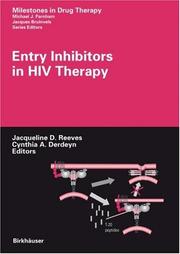
ISBN: 1280969911 9786610969913 3764377836 3764377828 Year: 2007 Publisher: Basel ; Boston : Birkhauser Verlag,
Abstract | Keywords | Export | Availability | Bookmark
 Loading...
Loading...Choose an application
- Reference Manager
- EndNote
- RefWorks (Direct export to RefWorks)
Entry Inhibitors in HIV Therapy presents the current status of this relatively new and highly dynamic class of inhibitors and provides a unique overview of obstacles and considerations for HIV entry inhibition compared to other antiretroviral targets. The introductory chapters of this book present an overview of entry inhibitors, review current knowledge of how Env mediates entry, and discuss the challenge of genetic diversity in this region of the viral genome. Subsequent chapters feature current information on individual classes of entry inhibitors that target each step of the virus entry pathway, from attachment to membrane fusion. There is an emphasis on the complex determinants of entry inhibitor susceptibility, resistance mechanisms, the need for clinical phenotyping, and how these issues create new challenges for antiretroviral therapy. Encouraging pre-clinical studies of entry inhibitors as microbicidesare also discussed. The final chapters highlight the current status of entry inhibitors in clinical studies, the major milestone achieved with FDA approval of enfuvirtide, and review drug development, past and present. In summary, this book presents a comprehensive and current overview of entry inhibitors from an expert panel of authors with diverse backgrounds and perspectives, incorporating many unrelenting successes against a backdrop of formidable challenges. It is of interest to basic science researchers as well as clinical physicians.
HIV infections --- Chemotherapy. --- HIV (Viruses) infections --- HTLV-III infections --- HTLV-III-LAV infections --- Human T-lymphotropic virus III infections --- Lentivirus infections --- Sexually transmitted diseases --- Toxicology. --- Immunology. --- Medical virology. --- Emerging infectious diseases. --- Pathology. --- Cytology. --- Pharmacology/Toxicology. --- Virology. --- Infectious Diseases. --- Cell Biology. --- Cell biology --- Cellular biology --- Biology --- Cells --- Cytologists --- Disease (Pathology) --- Medical sciences --- Diseases --- Medicine --- Medicine, Preventive --- Emerging infections --- New infectious diseases --- Re-emerging infectious diseases --- Reemerging infectious diseases --- Communicable diseases --- Medical microbiology --- Virology --- Virus diseases --- Immunobiology --- Life sciences --- Serology --- Chemicals --- Pharmacology --- Poisoning --- Poisons --- Toxicology --- Pharmacology. --- Infectious diseases. --- Cell biology. --- Microbiology --- Drug effects --- Medical pharmacology --- Chemotherapy --- Drugs --- Pharmacy --- Physiological effect
Book
ISBN: 038771362X Year: 2007 Publisher: New York, NY : Springer US : Imprint: Springer,
Abstract | Keywords | Export | Availability | Bookmark
 Loading...
Loading...Choose an application
- Reference Manager
- EndNote
- RefWorks (Direct export to RefWorks)
Researchers into HIV/AIDS face a gamut of ethical as well as scientific challenges. By viewing the gathering of data as a reciprocal activity between researchers, participants, and their communities, the expert contributors to Case Studies in Ethics and HIV Research bring these challenges to the fore. Studies from the United States and abroad depict the ongoing balance of risks and benefits while analyzing issues that range from confidentiality and informed consent to conducting studies with minority and other marginalized populations, from dealing with government and other funding agencies to ownership of findings. The book’s 25 collaborators offer readers new templates for devising and conducting studies that are valid, meaningful, and morally sound, with critical implications for all research involving human subjects. Twelve case studies illuminate key ethical issues in HIV research and real-world approaches to addressing them, including: Recruiting and selecting study participants. Providing proper standards of care to control groups. Improving researcher safety in the field. Special issues in conducting research: activity-identified populations (e.g., IV drug users), children, cognitively-impaired persons, multiple sites. Community outreach in service evaluation. Training the new generation of researchers. Improved study design and methodology, and improved outcomes for participants are important steps on the way to preventing and stopping the spread of AIDS. For professionals in public health research, the collective knowledge of Case Studies in Ethics and HIV Research will help to map out the road ahead.
HIV infections --- Research --- Moral and ethical aspects. --- Moral and ethical aspects --- Methodology --- Research. --- Methodology. --- HIV (Viruses) infections --- HTLV-III infections --- HTLV-III-LAV infections --- Human T-lymphotropic virus III infections --- Lentivirus infections --- Sexually transmitted diseases --- Medical ethics. --- Medicine. --- Epidemiology. --- Theory of Medicine/Bioethics. --- Public Health. --- Health Promotion and Disease Prevention. --- Diseases --- Public health --- Clinical sciences --- Medical profession --- Human biology --- Life sciences --- Medical sciences --- Pathology --- Physicians --- Biomedical ethics --- Clinical ethics --- Ethics, Medical --- Health care ethics --- Medical care --- Medicine --- Bioethics --- Professional ethics --- Nursing ethics --- Social medicine --- Health Workforce --- Public health. --- Health promotion. --- Health promotion programs --- Health promotion services --- Promotion of health --- Wellness programs --- Preventive health services --- Health education --- Community health --- Health services --- Hygiene, Public --- Hygiene, Social --- Public health services --- Public hygiene --- Social hygiene --- Health --- Human services --- Biosecurity --- Health literacy --- Medicine, Preventive --- National health services --- Sanitation
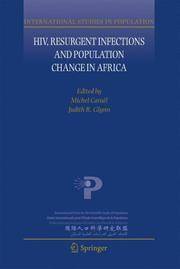
ISBN: 128111734X 9786611117344 1402061749 1402061722 1402061730 Year: 2007 Volume: v. 6 Publisher: Dordrecht : Springer,
Abstract | Keywords | Export | Availability | Bookmark
 Loading...
Loading...Choose an application
- Reference Manager
- EndNote
- RefWorks (Direct export to RefWorks)
Forty years ago, the age-old battle against infectious diseases as a major threat to human health was believed close to being won. However, by the late twentieth century, the increase of emerging and reemerging infectious diseases was evident in both low and high income countries. About 30 new infectious diseases have been identified in the last 20 years. Among the "new" diseases, and most importantly, the Human Immunodeficiency Virus (HIV) epidemic, with 40 million persons infected and 25 million deaths since its first description, presents one of the most significant health, societal and security challenges facing the global community. The interaction of HIV/AIDS with tuberculosis, malaria and bacterial infections have increased HIV-related morbidity and mortality, and in turn, the HIV pandemic has brought about devastating increases in tuberculosis. Understanding the population impact and the dynamics of infection diseases in the most affected region is critical to efforts to reduce the morbidity and mortality of such infections, and for decisions on where to use limited resources in the fight against infections. This book aims to contribute to these efforts by offering a demographic and epidemiological perspective on emerging and reemerging infections in sub-Saharan Africa.
Communicable diseases --- HIV infections --- Epidemiology. --- Africa, Sub-Saharan --- Population. --- Contagion and contagious diseases --- Contagious diseases --- Infectious diseases --- Microbial diseases in human beings --- Zymotic diseases --- Diseases --- Infection --- Epidemics --- HIV (Viruses) infections --- HTLV-III infections --- HTLV-III-LAV infections --- Human T-lymphotropic virus III infections --- Lentivirus infections --- Sexually transmitted diseases --- Africa, Black --- Africa, Subsaharan --- Africa, Tropical --- Africa South of the Sahara --- Black Africa --- Sub-Sahara Africa --- Sub-Saharan Africa --- Subsahara Africa --- Subsaharan Africa --- Tropical Africa --- Emerging infectious diseases. --- Demography. --- Medicine. --- Social sciences. --- Infectious Diseases. --- Medicine/Public Health, general. --- Social Sciences, general. --- Public health --- Behavioral sciences --- Human sciences --- Sciences, Social --- Social science --- Social studies --- Civilization --- Clinical sciences --- Medical profession --- Human biology --- Life sciences --- Medical sciences --- Pathology --- Physicians --- Historical demography --- Social sciences --- Population --- Vital statistics --- Emerging infections --- New infectious diseases --- Re-emerging infectious diseases --- Reemerging infectious diseases --- Health Workforce --- Infectious diseases.
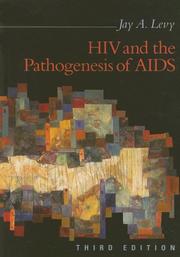
ISBN: 9781555813932 1555813933 9781555815653 1555815650 128303395X 9781283033954 9786613033956 6613033952 9781683671671 1683671678 Year: 2007 Publisher: Washington, D.C.
Abstract | Keywords | Export | Availability | Bookmark
 Loading...
Loading...Choose an application
- Reference Manager
- EndNote
- RefWorks (Direct export to RefWorks)
This new edition provides a state-of-the-art review of the current research, explains the history of the disease, and examines how scientists, clinicians, and public health workers have responded to the challenges presented by HIV/AIDS in the 25 years since its recognition.
HIV (Viruses) --- HIV infections --- Virus de l'immunodéficience humaine --- Infections à VIH --- Pathogenesis. --- Pathogenèse --- HIV Infections --- Acquired Immunodeficiency Syndrome --- HIV. --- etiology. --- physiopathology. --- HIV (Viruses). --- Etiology. --- Physiopathology. --- Acquired immunodeficiency syndrome --- Hiv (viruses). --- Hiv infections --- Hiv. --- Virus de l'immunodéficience humaine --- Infections à VIH --- Pathogenèse --- HIV (Viruses) infections --- HTLV-III infections --- HTLV-III-LAV infections --- Human T-lymphotropic virus III infections --- Lentivirus infections --- Sexually transmitted diseases --- AIDS-associated retrovirus --- AIDS virus --- ARV (Viruses) --- HTLV-III (Viruses) --- HTLV-III-LAV (Viruses) --- Human immunodeficiency viruses --- Human T-cell leukemia virus III --- Human T-cell lymphotropic virus III --- Human T-lymphotropic virus III --- IDAV (Viruses) --- Immunodeficiency-associated virus --- LAV (Viruses) --- LAV-HTLV-III (Viruses) --- Lymphadenopathy-associated virus --- T-lymphotrophic virus III, Human --- HTLV (Viruses) --- Virus-induced immunosuppression

ISBN: 0821369873 1281000914 0821369881 Year: 2007 Publisher: Washington, D.C. : World Bank,
Abstract | Keywords | Export | Availability | Bookmark
 Loading...
Loading...Choose an application
- Reference Manager
- EndNote
- RefWorks (Direct export to RefWorks)
Although the importance of infrastructure sectors in achieving economic growth and poverty reduction is well established, raising debt and equity capital for infrastructure development and service provision has been a challenge for developing countries. Risk mitigation instruments facilitate the mobilization of commercial debt and equity capital by transferring risks that private financiers would not be willing to take to third-party official and private institutions that are capable of taking such risks. There has been increasing interest and discussion on risk mitigation instruments in the
Infrastructure (Economics). --- Public investments --- Public health --- HIV infections --- AIDS (Disease) --- Education --- Business & Economics --- Economic History --- Finance --- Prevention --- Finance. --- Prevention. --- Children --- Education, Primitive --- Education of children --- Human resource development --- Instruction --- Pedagogy --- Schooling --- Students --- Youth --- Acquired immune deficiency syndrome --- Acquired immunodeficiency syndrome --- Acquired immunological deficiency syndrome --- HIV (Viruses) infections --- HTLV-III infections --- HTLV-III-LAV infections --- Human T-lymphotropic virus III infections --- Community health --- Health services --- Hygiene, Public --- Hygiene, Social --- Public health services --- Public hygiene --- Sanitary affairs --- Social hygiene --- Government investments --- Investments, Public --- Civilization --- Learning and scholarship --- Mental discipline --- Schools --- Teaching --- Training --- Immunological deficiency syndromes --- Virus-induced immunosuppression --- Lentivirus infections --- Sexually transmitted diseases --- Health --- Human services --- Biosecurity --- Health literacy --- Medicine, Preventive --- National health services --- Sanitation --- Expenditures, Public --- Investments --- Capital budget --- Economic development projects --- Investment of public funds
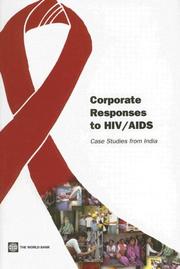
ISBN: 0821371711 9786610940394 1280940395 082137172X Year: 2007 Publisher: Washington, D.C. : World Bank,
Abstract | Keywords | Export | Availability | Bookmark
 Loading...
Loading...Choose an application
- Reference Manager
- EndNote
- RefWorks (Direct export to RefWorks)
AIDS (Disease) -- India -- Prevention -- Case studies. --- AIDS (Disease) -- Patients -- Employment -- India -- Case studies. --- AIDS (Disease) -- Social aspects -- India -- Case studies. --- Employee health promotion -- India -- Case studies. --- HIV infections -- India -- Prevention -- Case studies. --- HIV-positive persons -- Employment -- India -- Case studies. --- Industrial hygiene -- India -- Case studies. --- AIDS (Disease) --- HIV infections --- HIV-positive persons --- Employee health promotion --- Industrial hygiene --- HIV Infections --- Organization and Administration --- Organizations --- Health Promotion --- Methods --- India --- Sexually Transmitted Diseases, Viral --- Immunologic Deficiency Syndromes --- Preventive Health Services --- Asia, Western --- Investigative Techniques --- Health Care Economics and Organizations --- Lentivirus Infections --- Health Care Facilities, Manpower, and Services --- Health Services Administration --- Health Services --- Health Care --- Immune System Diseases --- Analytical, Diagnostic and Therapeutic Techniques and Equipment --- Retroviridae Infections --- Sexually Transmitted Diseases --- Asia --- Diseases --- Geographic Locations --- RNA Virus Infections --- Virus Diseases --- Geographicals --- Communicable Diseases --- Public Health --- Health & Biological Sciences --- Prevention --- Employment --- Patients --- Social aspects --- Employees --- Health of workers --- Hygiene, Industrial --- Industrial health engineering --- Occupational health and safety --- Occupational safety and health --- Occupations --- Work environment --- Employee wellness programs --- Health promotion in the workplace --- Occupational health promotion --- Workplace health promotion --- Worksite health promotion --- Acquired immune deficiency syndrome --- Acquired immunodeficiency syndrome --- Acquired immunological deficiency syndrome --- HIV-infected persons --- HIV patients --- HIV-sero-positive persons --- HIV-seropositive persons --- People living with HIV/AIDS --- Positive persons, HIV --- -Sero-positive persons, HIV --- -Seropositive persons, HIV --- -HIV (Viruses) infections --- HTLV-III infections --- HTLV-III-LAV infections --- Human T-lymphotropic virus III infections --- Health and hygiene --- Health aspects --- Health promotion --- Environmental health --- Industrial management --- Medicine, Industrial --- Occupational health services --- Immunological deficiency syndromes --- Virus-induced immunosuppression --- -Patients --- HIV (Viruses) infections --- Lentivirus infections --- Sexually transmitted diseases --- -Lentivirus infections
| Listing 1 - 10 of 12 | << page >> |
Sort by
|

 Search
Search Feedback
Feedback About UniCat
About UniCat  Help
Help News
News